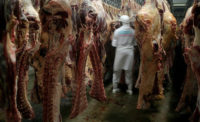Regulations & Legislation
FSIS’ new approach to Salmonella performance standards

On Jan. 26, 2015, the Food Safety and Inspection Service (FSIS) published a Notice in the FederalRegister regarding Salmonella performance standards. Importantly, this Notice is not limited to proposed new standards for chicken parts and comminuted poultry. FSIS is proposing several significant changes in how it will adopt and verify compliance with Salmonella performance standards for all raw products subject to a standard. Changes include:
Adoption of a performance standard,
Sampling window and determination of category, and
Web posting of category.
Adoption of a Performance Standard: Previously, when FSIS set a standard, it conducted a baseline and adopted a standard equal to the average. With a perfect distribution, this meant that 50 percent of the establishments would meet the standard and 50 percent would fail. FSIS did not follow this approach in developing the new poultry standards. Rather than looking where industry is in terms of performance, FSIS focused on where the agency wanted to be in terms of public health protection. Put another way, FSIS set the standards based on how much of a reduction in Salmonellaincidence for various products will result in reduction of illnesses so as to meet Healthy People 2020 goals.
Through a calculation based on reduction goals and how many illnesses are attributed to certain products, FSIS identified performance standards of 25 percent for comminuted chicken, 13.5 percent for comminuted turkey and 15.4 percent for chicken parts. FSIS focused on illness reduction, not industry performance. The net effect is that more than one-half of establishments would currently fail these standards. In the case of chicken parts, FSIS estimates 63 percent of establishments would fail that standard. One would expect similar failure rates for other raw products, including raw ground beef.
Sampling Window and Determination of Category: FSIS will no longer use a discrete sample set to determine compliance. To better estimate prevalence and to eliminate certain biases in a sample set approach, FSIS will adopt a moving window.
For large establishments, FSIS will sample weekly. For other establishments, the agency will decrease the number of samples taken based on production volume, so lower-volume establishments will be tested less frequently. The very low-volume establishments may only be tested three or four times per year. For certain high-risk products, the agency may draw samples as frequently as six times per month.
FSIS will maintain the category definitions:
For Category 1 status, the establishment has to be at or below 50 percent of the standard in all completed moving windows.
For Category 2, the establishment is over 50 percent of the standard but has not exceeded the standard in any completed moving window.
For Category 3, the establishment exceeded the standard during any completed window.
Compliance will be determined by an establishment’s performance in each and every completed moving window. If an establishment is tested weekly, the moving window will be the last 52 samples. In other words, once a moving window set of 52 has been completed, the 53rd sample replaces the first so that 52 samples remain in the window. So, if any moving window containing 52 results is at or over 50 percent of the standard, the establishment falls into Category 2. If any 52-week moving window is over the standard, the establishment is Category 3. Given the moving window represents a year, once in Category 2 or 3, it can take time to move out of that category.
Web Posting: Currently, FSIS only posts establishments in Categories 2 and 3. According to FSIS, this partial posting confused industry and consumers as to whether an unposted establishment was in Category 1 or had not yet been designated. To eliminate any confusion, FSIS will post the category of allestablishments, even establishments designated as Category 1. It is unclear what the implications of posting all establishments will be, (e.g., international trade partners where several countries have a zero tolerance for Salmonella in raw products).
Summary: As noted above, FSIS will change how it will adopt and verify compliance with performance standards. If industry maintains its current performance, one can expect almost two-thirds of industry will fail standards adopted with the new approach. Moreover, with use of a moving-window approach, which does not take into account seasonality or process variation, one can expect an increase in the number of establishments posted in Categories 2 and 3 on the agency’s web page.
Comments are due on the Notice by March 27, 2015.
Looking for a reprint of this article?
From high-res PDFs to custom plaques, order your copy today!







